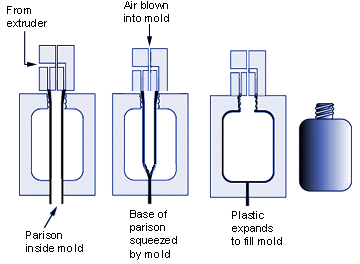Blow Molding Manufacturing and Design
Blow Molding Manufacturing & Design Considerations
Blow molding (Extrusion Blow Molding) is a manufacturing process that forms hollow thermoplastics. A within a split mold cavity, air pressure is applied to a heated plastic material (called a parison) that expands similar to a balloon and is shaped against the walls of the mold cavity.The plastic is then allowed to cool and the part is ejected from the mold cavity. Typically, some post molding processes are incorporated to"Finish the molded part, such as trimming excess plastic deposits.

Advantages of Extrusion Blow Molding:
- Complex hollow elastomeric parts can molded
- Flash free
- Core-less
- With sequential material construction
- With multiple layers of like materials
- With integrated components
- In sizes that range from very small to very large
- No time needed for core ejection
- Rapid cooling
- Rapid production translates directly into savings.
- Low part weight due to thin walls
- Less expensive molds
- Reduced assembly cost
- Good dimensional precision
- Minor product weight variation
- Minimal trimming operations
Industry Technology in Blow Molding
All blow molding processes consist of 3 stages:
- Plastification of the thermoplastic material, normally by means of a single screw extruder.
- Production of a molten “pre-form? – either an extruded tube or “parison? in the case of so called extrusion blow molding, or an injection molded “pre-form? in the case of injection blow molding
- Inflation of the parison or “pre-form? (usually with air) in a blowing mold, followed by a de-molding and a part trimming operation.
Single Layer Blow Molding : This is the most common variation of extrusion blow molding. It uses one grade of thermoplastic pellets to create the part. While small parts can be extruded continuously in single layer, larger parts are generally manufactured intermittently. Molten plastic must first be forced into an accumulator before being extruded as a long paris.
Multi-Layer Blow Molding: Multi-layer parts can be manufactured by the intermittent extrusion of several materials. This process is excellent for applications requiring multi-functionality such as a barrier resin that cannot come in contact with the environment, or a combination of soft and hard materials using both rubbery and plastic properties in two different ways. If more than one material is needed, a multi-barrel machine is required.
Progressive (Successive) Blow Molding: Progressive blow molded parts are produced through the successive extrusion of two or more plastic materials. For example, hard and soft grades of Santoprene rubber can be used when mobility and sealing properties are needed in a single component. A hard grade of Santoprene rubber can also be alternated with polypropylene for applications that need both local flexibility and stiffness.
Flashless Blow Molding: A 3-D blow molding technique, flashless EBM, is now available in several different variations within industry. This technology results in multi-dimensional thermoplastic rubber parts. Higher tolerances are achieved with a significant reduction of scrap through this method. The technology adapts readily to AES TPEs, in both hard or soft grades. The necessary manufacturing equipment will have either a parison manipulator and/or a mold manipulator, or a die manipulator.
Injection Blow Molding: Typically: Injection blow molding is best for production of parts that are light (<100gm/<.22lb), short in length (<200mm/<7.87in), small in diameter (<100mm/<3.94in), and made from a single layer of material. Usually ready for immediate use directly out of the mold, they require very little finishing. This method of choice for certain TPE applications, including small, symmetrical, convoluted parts such as those used for automotive rack and pinion boots. Critical end fit areas can be formed with injection molded tolerances, while convoluted sections can be blown, for flexibility.
Press Blow Molding: This process variation combines injection blow molding with extrusion blow molding. Typical applications include small cylindrical and conical parts such as automotive rack and pinion boots, transmission boots or dust shields. The process provides the high control for product dimensions and wall thickness, as well as quick, efficient cycles with little scrap or mold/tool changeover. Currently, commercial equipment utilizes heads with shot sizes < 150gm (<.33lb). Press blow molding tooling requires both an injection mold and a conventional extrusion low mold.
Design Considerations Condensed:
Wall thickness should be as uniform as possible to facilitate rapid molding cycle time., conserve material and avoid uneven molding cool-down resulting in distortion.
- Where the end item is a bottle, and t he neck portion must have thicker wall than adjoining body, the body wall thickness should not exceed 2:1 ration.
- The draft angle should be perpendicular to the mold tool open direction. This will allow easy removal of the molded part.
- Sharp corner should be avoided, design wall features with radii transitions. The larger the radii the better.
Link to this Webpage:
© Copyright 2000 -
2024, by Engineers Edge, LLC
www.engineersedge.com
All rights reserved
Disclaimer |
Feedback
Advertising
| Contact